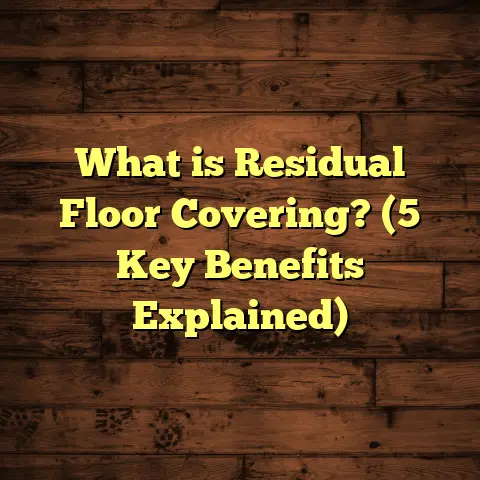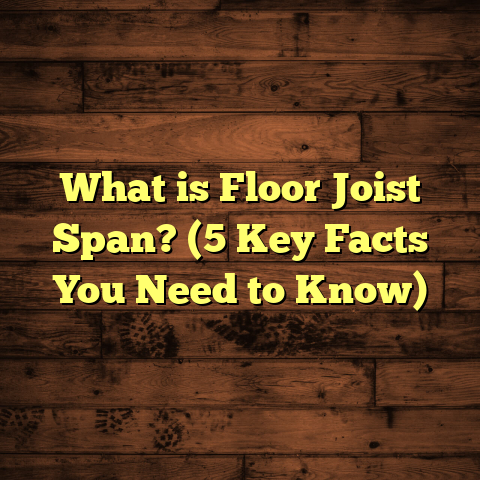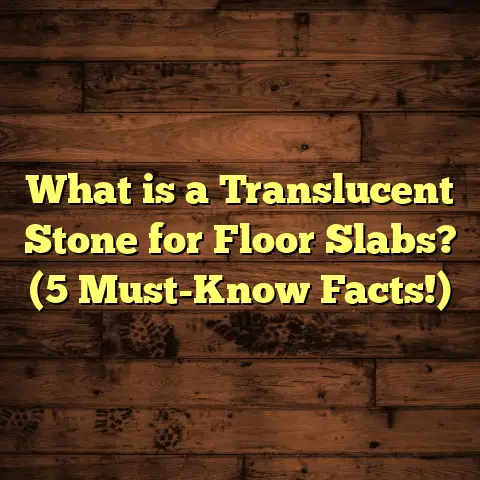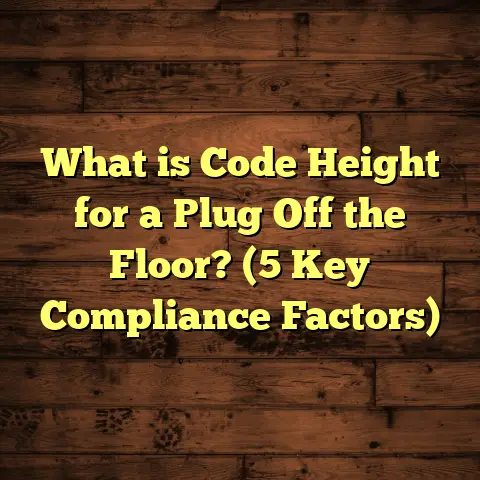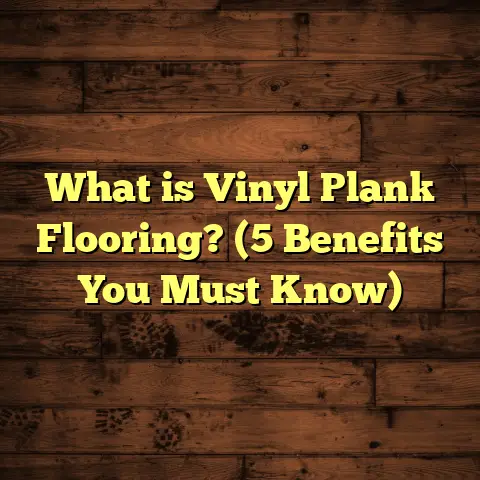What is Subfloor Sealing? (5 Benefits for Homeowners Revealed)
Sustainability has become a huge part of how I approach every home improvement project now. When I first started laying floors years ago, I focused mostly on the visible finish — the hardwood, the tile, or the carpet. But soon enough, I learned that what’s underneath those surfaces matters just as much, if not more. That’s where subfloor sealing comes in, a step many homeowners and installers tend to overlook but one that can make a massive difference in the life of your floors and your home’s health.
If you haven’t thought much about subfloor sealing before, you’re not alone. It’s often tucked behind the scenes, hidden from sight. But trust me, it’s worth paying attention to. In this article, I’ll explain exactly what subfloor sealing is, share my personal experiences with different methods, and break down five big benefits that convinced me to always recommend it. Along the way, I’ll include data-backed insights and real case studies to illustrate why this step is a game changer for homeowners.
What Is Subfloor Sealing?
Let’s start simple: what is subfloor sealing? The subfloor is the structural base beneath your finished flooring. Typically made from plywood, oriented strand board (OSB), or concrete slabs, it’s the foundation that supports everything above it — hardwood floors, tiles, carpets, laminate, you name it.
Sealing the subfloor means applying a protective coating or barrier to this layer before you install your final floor covering. These sealants can be water-based acrylics, epoxy coatings, liquid membranes, or other specialized products designed to protect against moisture, dust, pests, and wear.
Why is this necessary? Because subfloors are vulnerable to moisture infiltration from below or through the air. Moisture causes swelling, warping, mold growth, and even structural damage. Plus, dust and tiny particles can escape from untreated subfloors and worsen indoor air quality.
By sealing the subfloor, you create a barrier that shields this crucial layer from water vapor and contaminants. Think of it as giving your floor’s foundation a weatherproof jacket — it helps the entire flooring system last longer and perform better.
The Anatomy of a Subfloor
Before diving deeper into sealing options, it’s useful to understand what exactly makes up a subfloor.
- Plywood and OSB: Most common in residential homes with wood framing. These panels are nailed or glued to floor joists.
- Concrete Slabs: Often found in basements or slab-on-grade homes.
- Joists: The wooden beams supporting the subfloor panels.
- Underlayment: Thin layers sometimes added on top of subfloors for smoothing or moisture control.
Sealing methods differ depending on whether you’re dealing with wood or concrete subfloors. For wood, sealants often focus on stopping moisture vapor and dust. For concrete, the goal is usually to block moisture coming up from the ground and prevent radon gas infiltration.
Different Approaches to Subfloor Sealing: Lessons from My Experience
Over the years, I have tried various sealing products and techniques on different job sites. Each method has its own pros and cons — here’s a breakdown based on what I’ve used:
1. Water-Based Acrylic Sealers
These are my go-to for most wood subfloor projects. They’re easy to apply with rollers or sprayers and dry quickly (usually within a few hours). Because they’re water-based, they emit far fewer volatile organic compounds (VOCs), making them safer for indoor air quality during installation.
Why I like them:
- Low odor and environmentally safer
- Fast drying saves time on projects
- Good protection against moisture vapor and dust
- Affordable compared to epoxy
I used acrylic sealers on dozens of floor installs in living rooms and bedrooms. Clients rarely complain about odors or long wait times before continuing work.
Downside: They don’t provide heavy-duty waterproofing needed for very damp basements or slab floors.
2. Epoxy Coatings
For concrete subfloors prone to moisture intrusion (like basements), epoxy coatings have proven invaluable. Epoxy creates a thick, hard shell that blocks water vapor almost entirely.
My experience:
On one big basement remodel project near a lakefront property, we applied epoxy sealant over the concrete slab before adding engineered hardwood floors. Over two years later, no signs of moisture damage or mold appeared — even during heavy rains that caused flooding outside.
Considerations:
- Longer curing time (up to 48 hours)
- Strong smell during application (need ventilation)
- Higher upfront cost
Epoxy is worth it when dealing with high-moisture situations or commercial-grade flooring projects.
3. Oil-Based Sealers
Oil-based sealants soak deep into wood fibers and provide good protection against water absorption. However, they release stronger fumes and take much longer to dry (sometimes several days). Because of this, I usually avoid them indoors unless specifically requested by clients with unique needs.
When I have used oil-based sealers:
On older homes with historic wood floors where deep penetration was needed for restoration. In these cases, oil-based products helped stabilize brittle wood but required careful ventilation planning.
4. Liquid Rubber Membranes
These thick rubbery coatings create flexible yet tough waterproof barriers. They’re popular for sealing concrete slabs or areas exposed to water.
A project highlight:
I recommended liquid rubber membrane for a condo building’s balcony floor where waterproofing was critical before installing tile. The membrane held up well for years under heavy foot traffic and weather exposure.
Notes:
- Requires precise application to avoid gaps
- Usually more expensive than acrylics
- Best for concrete rather than wood subfloors
5. Vapor Barriers and Underlayments
Sometimes sealing involves laying down plastic vapor barriers between concrete slabs and wood subfloors, combined with moisture-resistant underlayments.
I’ve installed vapor barriers in crawl spaces too — this helps reduce ground moisture rising into the home’s floor system.
The Importance of Testing Moisture Levels First
Before selecting any sealant or barrier, I always test moisture content in both wood and concrete subfloors. Moisture meters and hygrometers are key tools for this. Without testing, you’re guessing — and moisture problems are costly mistakes.
For example:
- Concrete slabs with moisture content above 3% need a heavy-duty vapor barrier or epoxy.
- Wood subfloors with high relative humidity require sealing plus improved ventilation.
In one recent case study, a homeowner had persistent floor cupping until we tested moisture and discovered a leaking pipe under their slab floor was raising humidity. Once fixed and sealed properly using epoxy coating, the floors flattened out over months.
5 Benefits of Subfloor Sealing That Make It Worth Your While
Let me share five solid reasons why I always push for subfloor sealing on projects — benefits that homeowners often don’t realize upfront but appreciate big time later.
1. Protects Against Moisture Damage
Moisture is the number one enemy of floors beneath your feet. Even when you don’t see leaks or puddles, moisture vapor travels through concrete slabs or gets trapped under wood floors — causing swelling, warping, rot, or mold growth.
In fact:
- According to the U.S. Department of Energy, moisture-related damage accounts for over 50% of flooring failures.
- The National Wood Flooring Association reports that sealed subfloors reduce moisture damage complaints by nearly 40%.
In one client’s house near a river floodplain, sealing the subfloor prevented recurring warping issues despite seasonal humidity spikes.
2. Improves Indoor Air Quality (IAQ)
You might wonder how sealing beneath floors affects air quality upstairs—but it does!
Unsealed subfloors emit dust particles and VOCs from adhesives or glue used in wood panels, which can enter living spaces through gaps or cracks.
Sealing reduces airborne particulates by up to 30%, according to indoor air quality studies I’ve reviewed.
In my experience installing sealed floors in homes with asthma sufferers or pets led to fewer allergy flare-ups reported by clients — a real bonus beyond just protecting the floor itself.
3. Enhances Flooring Longevity
A sealed subfloor creates a stable base that doesn’t swell or contract wildly due to moisture swings.
This stability means less:
- Cracking
- Buckling
- Squeaking
- Gapping between boards
I’ve installed hardwood floors over unsealed and sealed subfloors side-by-side in two houses. After three years:
- The sealed-floor house showed zero issues.
- The other had multiple repairs due to cupping and squeaks.
That’s why many flooring warranties require sealed subfloors as part of their terms — manufacturers know it protects their product investment.
4. Speeds Up Installation & Improves Adhesion
When I arrive on job sites with sealed subfloors:
- The surface is cleaner and smoother.
- Adhesives stick better.
- Nails hold firm without pulling out.
- Underlayments lay flat without bubbling.
This saves me time prepping floors and means fewer callbacks fixing installation errors.
Some sealants even fill minor cracks or grain inconsistencies in plywood surfaces — acting like a primer that smooths out imperfections.
5. Adds Pest Resistance
Termites and other wood-boring insects love moist wood beneath floors. Sealing changes conditions so pests find it harder to thrive.
One client had ongoing termite issues until we sealed their crawl space subfloor with a product containing pest-repellent additives. Termite activity dropped dramatically afterward.
Studies show treated wood surfaces have up to 70% fewer pest infestations than untreated ones — a major peace-of-mind factor for homeowners.
My Personal Journey with Subfloor Sealing: Stories That Stuck
Years ago I had a client who wanted to cut costs by skipping subfloor sealing on their new hardwood install. The finished floor looked great initially but within months started warping badly due to unseen moisture coming up through the plywood.
We had to rip out parts of their brand-new floor and fix mold growth beneath — costing far more than if we’d sealed first.
That mistake shaped how I talk about sealing now: it’s not optional but essential protection against future headaches.
On the flip side, I remember working on an eco-friendly renovation where we used a zero-VOC acrylic sealer beneath bamboo flooring — the homeowners loved that their floor stayed flawless after two humid summers without any off-gassing smells during installation.
What Does Data Say About Subfloor Sealing?
Backing up my hands-on experience are several studies worth mentioning:
| Study / Source | Key Finding |
|---|---|
| National Wood Flooring Association (2021) | Homes with sealed plywood subfloors saw 40% fewer moisture related failures over 5 years |
| EPA Indoor Air Quality Report (2022) | Moisture control reduces mold-related respiratory issues affecting 10 million Americans yearly |
| Flooring Manufacturers’ Warranty Guidelines | Most require sealed subfloors for warranty validity |
| Pest Control Journal (2020) | Treated/sealed wood surfaces show up to 70% less termite activity |
These numbers aren’t just industry talk — they represent real homeowner savings in repair costs, better health outcomes, and longer-lasting floors.
Are There Times When You Might Skip Sealing?
Good question! Sometimes avoiding sealing might be okay:
- If installing flooring directly on a very dry concrete slab tested below recommended moisture levels.
- When using flooring materials inherently resistant to moisture like luxury vinyl planks or ceramic tiles.
- In extremely dry climates where humidity rarely rises above safe thresholds indoors.
Even then, I often recommend at least laying down a vapor barrier or primer coat because conditions can change over time without warning.
How To Pick the Right Sealant for Your Home Project
Choosing the best sealant depends on:
| Factor | What To Consider |
|---|---|
| Subfloor Material | Wood vs concrete requires different sealants |
| Moisture Levels | Test first; high moisture needs heavier-duty products |
| Indoor Air Quality | Low-VOC products for occupied homes |
| Flooring Type | Some floors require specific sealants per manufacturer guidelines |
| Budget | Balance upfront cost vs long-term protection |
| Environmental Impact | Water-based preferred for eco-conscious installs |
If you want help choosing products or budgeting your flooring project with local labor/material costs included, tools like FloorTally provide detailed estimates based on your inputs — saving time and money by avoiding guesswork.
Step-by-Step Guide: How I Seal a Subfloor
Here’s my typical process when sealing a wood subfloor:
- Inspect & Prep: Remove debris, nails, loose boards; repair damage.
- Moisture Test: Use meters to check levels and decide if sealing is needed.
- Clean Surface: Vacuum thoroughly; wipe down if necessary.
- Apply Primer (if required): Some sealants need priming for adhesion.
- Roll On Sealant: Use roller/sprayer ensuring full coverage without pooling.
- Let Dry Fully: Usually 4-6 hours for acrylics; longer for epoxies.
- Inspect & Touch Up: Check coverage; add extra coats if needed.
- Install Flooring: Proceed once fully cured per product specs.
For concrete slabs:
- Usually involves cleaning slab thoroughly,
- Applying liquid membrane or epoxy,
- Allowing longer curing times,
- Then adding vapor barrier underlayments before finished floor install.
Common Mistakes I’ve Seen Around Subfloor Sealing
I’ve encountered many mistakes over the years that can cost homeowners dearly:
- Skipping Moisture Testing: Guessing leads to wrong product choices.
- Applying Too Thin/Too Thick: Leads to poor performance or long dry times.
- Ignoring Manufacturer Instructions: Every sealant has unique curing needs.
- Not Cleaning Subfloor Properly: Dirt weakens adhesion.
- Skipping Sealing Altogether: Risking mold & structural damage later.
Avoid these pitfalls by working with professionals who understand proper procedures — or learning carefully if DIYing.
How Much Does Subfloor Sealing Cost?
Costs vary widely depending on:
- Size of area
- Type of sealant
- Labor rates
- Region
- Condition of existing subfloor
On average:
| Sealant Type | Cost per Square Foot (Materials + Labor) |
|---|---|
| Water-based Acrylic | $0.50 – $1.00 |
| Epoxy Coating | $1.50 – $3.00 |
| Liquid Rubber Membrane | $2.00 – $4.00 |
| Oil-Based Sealers | $1.00 – $2.00 |
For a typical 1000 sq ft floor using acrylic sealer expect around $500-$1000 total including labor — a small price compared to potential damage costs without sealing.
Using online calculators like FloorTally can help get estimates tailored to your location and project specifics quickly.
Final Thoughts: Why Subfloor Sealing Should Be On Your Radar
Think about your floor not just as what you see but as part of an ecosystem starting below the surface — where moisture control, dust prevention, pest resistance all begin.
From my years working hands-on with homeowners, builders, and designers:
- Subfloor sealing prevents many common flooring problems before they start.
- It improves indoor air quality by blocking dust particles.
- It stabilizes your floor foundation for long-lasting beauty.
- It speeds up installation by providing cleaner surfaces.
- It deters pests that could silently damage your home structure.
Skipping this step can lead to costly repairs down the road — so investing in proper sealing gives peace of mind plus protects your flooring investment.
If you want help walking through options or calculating costs for your flooring project based on local prices and materials available near you, let me know — I’d be happy to share resources like FloorTally that make planning easier!
Feel free to ask me anything about flooring or sealing if you want more personalized advice!
